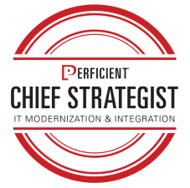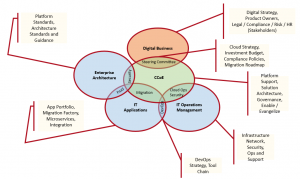This is the next installment in a series of blogs on the subject of cloud transformation. In general, a center of excellence (CoE) is a team of experts whose mission is to provide the organization best practices, guidance, and governance around a specific practice field. Establishing a CoE is often a first step to introduce new technology to an organization. A CoE addresses knowledge and skills gaps and establishes a path to organizational maturity in the topic of interest.
With regard to a cloud CoE (CCoE), IT cloud related surveys invariably cite skills gaps and talent pool shortages as major challenges to cloud adoption.
A CCoE addresses the cloud skills challenge and should be a part of most organizations cloud skills development strategy. The CCoE has a goal of maturing the organizations cloud delivery capabilities.
Gartner defines a CCoE as follows: “A cloud center of excellence (CCoE) is a centralized cloud computing governance function for the organization as a whole. It serves as an internal cloud service broker (CSB). It acts in a consultative role to both central IT, business unit IT and consumers of cloud services within the business. A CCoE can serve the needs of both agility-focused and efficiency-focused IT. It is a key ingredient for cloud-enabled IT transformation and is typically helps drive that transformation.”
Gartner’s definition of a CCoE is broad with an emphasis on governance – i.e. establishing a cloud brokerage, policies and guidelines. But equally important in many organizations, especially initially where quick wins are vital, is rapid developer enablement. In this blog, we will look at steps to establish a CCoE. This means balancing a quick start with immediate benefits to the long-term organizational needs for governance and maturity.
The Cloud Center of Excellence mission and goals should be aligned with the business as a whole. Which translates to the CCoE being structured to facilitate the corporate cloud strategy and application migration plans.
It is important to formally define a cloud strategy, if one does not exist. The rationale, scope and approach to migrate to the cloud can vary greatly. Common approaches to cloud migration include application lift-and-shift (re-platform with little change), replacement with software as a service (SaaS), and refactor/rewrite.
Your cloud migration strategy will greatly impact the focus of the CCoE. For example, if the scope of a cloud migration is part of a larger corporate-wide digital transformation, then the scope of the CCoE will be broad and must include cross-functional leadership from stakeholders across the business and IT. A CCoE for a company that largely replaces applications with SaaS will be different that a company that is mostly rewriting applications – the latter with a focus on application engineering and the former with a focus on application integration.
CCoE leadership is often provided by an executive sponsor and a steering committee of cross-functional leaders.
The executive sponsor adds visibility to the cloud migration program. They also have the organizational authority to initiate and communicate change and build a coalition of support across the enterprise. In addition to the executive sponsor, a cloud steering committee can help make strategic decisions and gain cross-functional consensus. Typical duties for the cloud steering committee include: providing strategic direction, approving standards and roadmaps, promoting the adoption of standards, and enforcing compliance policies.

The first step to create the CCoE is to define and ratify the leadership and organizational structure. Workshops with stakeholders can facilitate discussion to define and create models of the CCoE structure, roles, and responsibilities. The CCoE can then be defined as a set of models including a Venn diagram, organizational chart, and RACI matrix.
For complex organizations, it is best to define high-level models and then drill into the details to refine the organizational roles and responsibilities across functional groups – i.e. start with a Venn diagram and proceed to detailed RACI diagrams once you have high-level consensus on the organizational roles.
The CCoE organizational roles will evolve over time as the organization as a whole matures cloud capabilities. For example, a move from a centralized shared-services model to a federated model. It is important to plan for these organizational transitions and to set maturity goals, measured with KPIs, to ensure cross-functional teams progress towards the desired state of maturity. Defining a cloud maturity model, KPIs, and a roadmap toward maturity are needed, especially for large organizations to ensure timely, incremental progress to maturity.
Once you have the organizational structure and maturity plans, it is necessary to define a cloud governance model.
The governance model should be lightweight and helpful versus burdensome and bureaucratic. Focuses for cloud governance include steps to ensure security compliance, implementation of reference architectures, and optimization of capacity and consumption. Tools to define cloud governance include the definition of guiding architecture principles, reference architecture and reference implementations, and workflows and policies. Workflows define the steps and approvals needed for common cloud-related activities. For example, onboarding a new cloud application or creating a new version of a microservices API.
The CCoE can greatly increase the velocity of cloud migration and adoption by providing developers the tools and guidance they need to migrate applications to the cloud and create green-field cloud applications. For example, the CCoE can define reference architecture for common application types, such as 12-factor web apps and microservices.
Also, a deployable reference implementation complete with a CI/CD pipeline is extremely helpful. The ability for a development team to quickly provision their environment and build a new application greatly enhances developer productivity. Further information on this topic can be found in the blog “Establishing Cloud Reference Architecture and Best Practices”.
The concept of a cloud migration factory can be set up within the CCoE if a goal of an organization is large-scale cloud migration. The cloud migration factory embodies the people, processes, and tools needed to plan, execute, and support ongoing workload migrations. More information on cloud migrations can be found in the blog, “Developing a PaaS Migration Strategy”.
The following is a recap of the high-level steps to consider when implementing a Cloud Center of Excellence:
- Align the CCoE with the corporate cloud strategy
- Define the organizational and funding model
- Identify executive sponsorship and the steering committee personnel
- Define the CCoE roles and responsibilities
- Define the CCoE maturity model and KPIs
- Create the cloud migration roadmap (people, process and platforms)
- Define reference architecture and reference implementations for common application patterns
- Define developer’s guidelines, patterns and standards for building and deploying their applications
- Measure with KPIs and evolve the CCoE over time as cloud capabilities mature
Perficient has teams of highly experienced cloud strategists, architects, DevOps, and change management experts should you need any help setting up your Cloud Center of Excellence. Our Cloud Quick Start has CCoE templates, models, best practices, and reference architecture that speeds cloud adoption. We have invested in training experienced individuals on the latest development approaches, including native-cloud development, PaaS, DevOps, microservices, and re-platforming.

